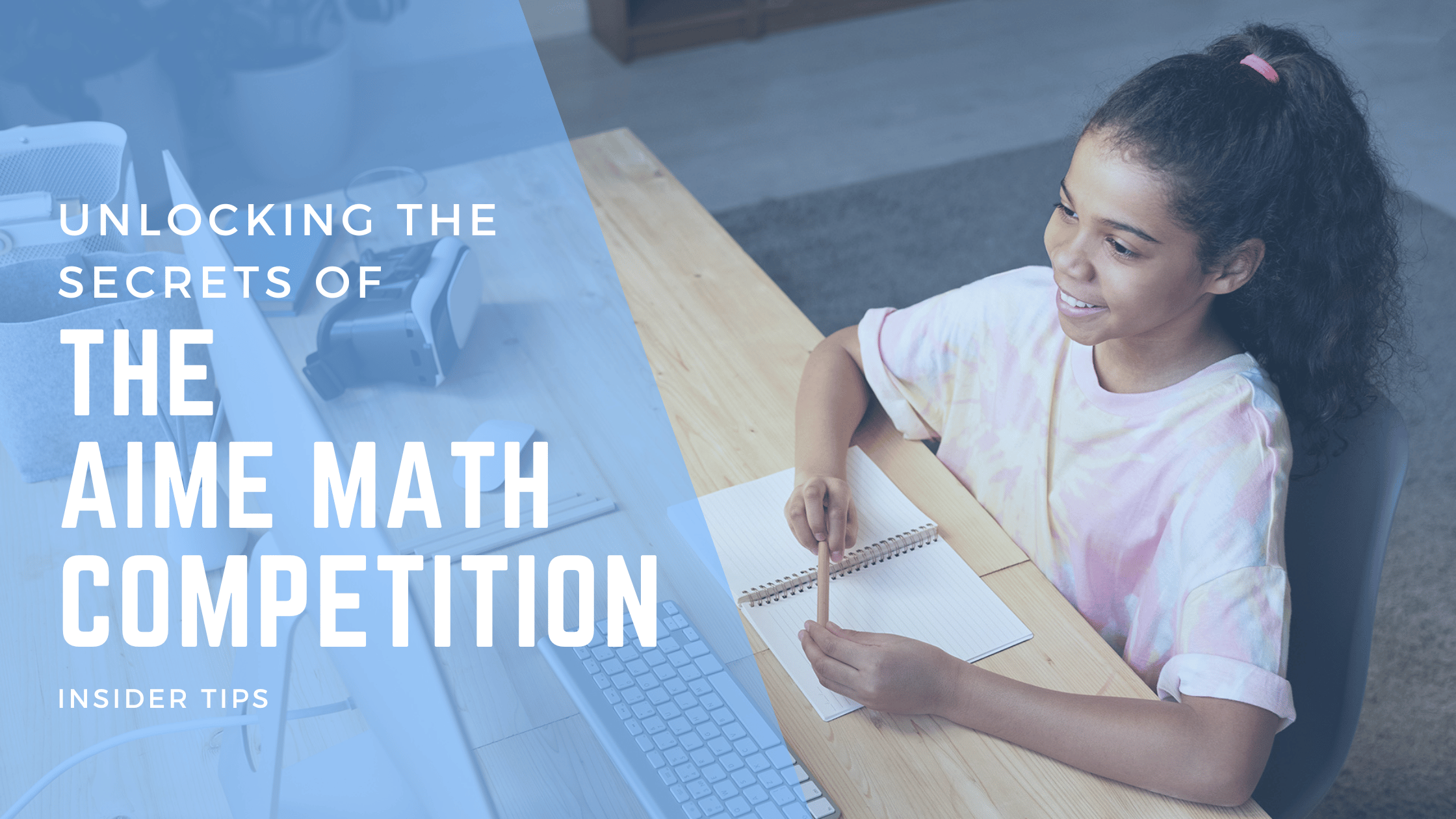The
American Invitational Mathematics Examination (AIME) is one of the most prestigious and difficult high school math competitions in the United States. It’s the second stage of the American Mathematics Competitions (AMC) series, and only the top 5% of AMC 10/12 test-takers are invited to participate. It’s a stepping stone to more challenging competitions like the USAMO and the IMO.
To match the challenge, the USA Mathematical Olympiad (USAMO) and the International Mathematical Olympiad (IMO) are even more prestigious. If you win either of these competitions, you’ll be a shoo-in for any top college or scholarship program.
Understanding the AIME format and scoring
The AIME has 15 questions that get progressively harder. Each answer is an integer between 0 and 999. You have 3 hours to complete the test, and you can’t use calculators or other electronic devices. You can only use pencils, erasers, rulers, and compasses.
The AIME covers topics in:
- Elementary algebra
- Geometry
- Trigonometry
- Number theory
- Probability, and
- Combinatorics
A lot of the material on the AIME isn’t covered in high school math classes, so you’ll need to study and practice on your own or find an excellent tutor. You can find some sample problems and solutions on the
AMC website.
The AIME is different from the AMC in that it requires you to write your answers as 3-digit integers. For example, if the answer is 42, you write 042. If the answer is 0, you write 000. If your answer isn’t an integer or is more than 3 digits long, you’re out of luck. Each question is worth 10 points, and unlike the AMC 8, 10, and 12, there’s no penalty for wrong answers, so try to answer every question.
Your AIME score will determine if you qualify for the USAMO, or the USA Mathematical Olympiad, which is the third and final round of the AMC series. The USAMO is a 6-question, 9-hour proof-based test that’s extremely challenging and selective. Only about 500 students in the country make it to this level each year. To qualify for the USAMO, you need to have a high AMC score and a high AIME score. The exact cutoffs vary from year to year, but they’re usually around 100 points for the AMC 10 and 120 points for the AMC 12. For the AIME, the cutoffs are usually around 8 or 9 questions correct out of 15.
To qualify for the AIME, you must score at least 100 out of 150 on the AMC 12 or be in the top 5% of all participants. Otherwise, you need at least 120 out of 150 on the AMC 10 or be in the top 2.5%. There are two different versions of the AIME: the AIME I and the AIME II. However, you can only take one of these two tests, depending on the date of your AMC 10 or AMC 12. The AIME I is usually held in March and the AIME II is usually held in April.
Effective study strategies for AIME success
If you’re aiming for AIME success, you need to study smart, not just hard. The AIME tests your problem-solving skills and creativity, not just your memorization and calculation, so you need strategies that improve your understanding of the subject matter. Well, we’ve got a few for you, all tried and tested:
Review the AMC 10/12 problems and solutions
The AIME is based on the same topics and concepts as the AMC 10/12, but with more depth and difficulty. You can learn a lot from studying the AMC 10/12 problems and solutions, especially the more challenging ones or ones that involve multiple steps.
Practice with past AIME problems and solutions
You can find them online or in books. Try to solve them on your own first, then check the solutions and learn from your mistakes. You can also time yourself and simulate the test conditions to improve your speed and accuracy.
Learn new techniques and tricks
The AIME often makes you use clever techniques and tricks to solve problems. These tricks include modular arithmetic, Vieta’s formulas, the pigeonhole principle, and more. You can learn these techniques and tricks from books, videos, websites, or from a tutor. You might even be able to come up with your own techniques and tricks by playing around with numbers and equations.
Join a study group or a mentorship program
Studying with others can be a great way to prepare for the AIME. You can join a study group with your friends or classmates, or
find a tutor who has experience with the test. When you study with others, you can exchange ideas, ask questions, share resources, and challenge each other with problems. This can help you to learn new material, identify areas where you need more help, and stay motivated.
Have fun and enjoy the process
The AIME is not only a test but also a game and a puzzle. You should have fun and enjoy the process of solving the problems, not just focus on the results. The more you enjoy the process, the more you will learn and improve.
Problem-solving techniques for complex AIME problems
In the AIME, some problems might seem too hard or too long to solve. But if you know what you’re doing, if you have the right techniques in the
figurative palm of your hand, these complex challenges become routine. Here are some techniques:
Look for patterns and symmetries
Sometimes, a complex problem can be simplified by noticing a repeating pattern or symmetry in the given or required information. For example, if you are asked to find the last digit of a large power, you can look for the cycle of the last digits of smaller powers.
Use algebra and equations
In some cases, a complex problem can be translated into an algebraic equation or system of equations that can be solved more easily. For example, if you are asked to find the number of positive integers that satisfy a certain condition, you can try to write an equation that represents that condition and solve for the unknowns.
Use logic and contradiction
It’s possible to solve a complex problem using logical reasoning and eliminating impossible cases. For example, if you are asked to prove or disprove a statement, you can try to assume the opposite and look for a contradiction.
Use geometry and diagrams
Complex problems can be simplified by visualizing them with a diagram or using geometric properties. For instance, if you need to find the area of a shape, you can try to break it down into simpler shapes or use formulas like the Pythagorean theorem or Heron’s formula.
Use combinatorics and counting
Sometimes, you can solve a complex problem by counting the number of ways to arrange or choose certain elements. For example, if you are asked to find the probability of an event, you can try to count the favorable and total outcomes or use formulas like binomial coefficients or the inclusion-exclusion principle.
To illustrate a technique, let’s look at an example problem and solution from past AIME exams.
Example: Find the last two digits of \( 9^{2021} \).
Solution: There is a pattern to be found here. If you look at a table of the geometric progression of \( 9^n \), you’ll notice that the last digit cycles through \( 9, 1, 9, 1, \ldots \) every other power. That is, the last digit of \( 9^n \) is 9 when n is odd, and is 1 when n is even. So, the last digit of \( 9^{2021} \) is the same as the last digit of \( 9^1 \), which is 9.
To find the second last digit, we can use the binomial theorem.
$$
9n = (10 – 1)^n = 10^n – n \times 10^{n – 1} + \ldots + (-1)^n
$$
The second last digit of \( 9^n \) is determined by the last digit of the term \( -n \times 10^{n – 1} \), which is -10 times the last digit of \( n \). So, the second last digit of \( 9^{2021} \) is -10 times the last digit of 2021, which is -10 times 1, which is 0.
Therefore, the last two digits of \( 9^{2021} \) are 09.
We could have used modular arithmetic or Euler’s theorem, but that’s a more involved process.
Time management skills during preparation and competition
Time management skills are crucial for any test or competition on a time limit, both before and during the exam. Here are some tips to help you effectively manage your time for the AIME.
Make a plan
Before the exam, make a study plan that covers all the topics and skills you need to review. Give yourself enough time to study each topic, but also leave some room for flexibility and revision. Don’t cram everything in the last minute, because this will only make you more stressed and less likely to remember what you’ve learned.
Keep track of time
During the exam, keep track of the time and the number of questions you have left. The AIME has 15 questions in 3 hours, which means you have an average of 12 minutes per question. However, some questions may be easier or harder than others, so you should adjust your pace accordingly. Don’t spend too much time on one question, especially if you’re stuck or unsure. You can always come back to it later if you have time left.
Save time with strategies
Use strategies to save time and avoid mistakes. For example, you can skip or simplify calculations by using estimation, symmetry, logic, or other tricks. You can also check your answers by plugging them back into the original problem or using a different method. If you are not confident about an answer, you can write down some partial work or reasoning to get partial credit.
Turning challenges into opportunities: A case study
Mathematics is a subject that many students find difficult and frustrating. However, some students can overcome their challenges and achieve remarkable results in math competitions. Meet AoPS user
Sag (RedFlame).
In fourth grade, he found out about the AMC 8 competition and was challenged by the fact that he was overshadowed by a high-achieving cousin in a cutthroat extended family. Despite scoring lower initially, RedFlame’s determination led him to the
Art of Problem Solving (AoPS) website in 2013.
AoPS was a game-changer, teaching him that perfection isn’t the goal; rather, it’s about making mistakes and learning from them. He started grinding — 50 Alcumus questions, five days a week, with a challenging 100 on Saturdays. RedFlame embraced problems outside his comfort zone, understanding that growth happens when you push boundaries.
The AMC 10 in 2018 was a turning point. While his cousin, unfamiliar with AoPS, scored 93, RedFlame’s score skyrocketed from an 8 on the AMC 8 to an impressive 124.5 on the AMC 10. The achievement brought pride and happiness to his family, but for RedFlame, the journey was always personal. It wasn’t just about making his parents proud; it was about the intrinsic rewards of personal success.
Your story can resemble this if you work at it and approach the AIME with a growth mindset. RedFlame had to work alone, but you can take advantage of excellent tutors like the ones at
WCTC to guide you through to brilliance, not just in the AIME, but in
any STEM course, test, or competition.
Starting your AIME journey with WCTC
As you start your journey to prepare for the AIME math competition, it’s important to have the right tools and guidance. The AIME is more than just a test of math skills. It’s a chance to explore the depths of problem-solving and critical thinking in the world of STEM. To make sure you’re on the right track, consider
starting your AIME journey with Wes Carroll Tutoring & Coaching (WCTC).
We are not here to just help you achieve mastery. That’s our baseline. We will help you go from being overwhelmed by math challenges to achieving results that far exceed what you thought yourself capable of. We have done this with thousands of students.
If you want to emerge as an example of exceptionality, please contact us. You can visit our
homepage or call us at
(415) 937-1729. Don’t miss this opportunity to unlock your full potential in math and beyond.




0 Comments